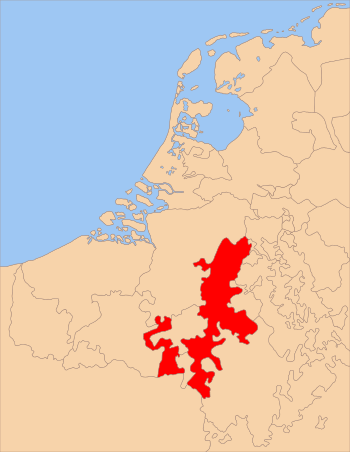Prince-Bishopric of Liège facts for kids
Quick facts for kids
Prince-Bishopric of Liège
|
|||||||
|---|---|---|---|---|---|---|---|
| 980–1795 | |||||||

The Prince-Bishopric of Liège around 1350.
|
|||||||
| Status | Ecclesiastic state of the Holy Roman Empire | ||||||
| Capital | Liège | ||||||
| Common languages | French, Dutch, German, Walloon | ||||||
| Religion | Roman Catholicism | ||||||
| Government | Principality | ||||||
| Prince-Bishop | |||||||
|
• 340s–384
|
Saint Servatius (first bishop, at Maastricht) | ||||||
|
• approximately 670-700
|
Saint Lambert (at Maastricht) | ||||||
|
• 972–1008
|
Notger (first prince-bishop) | ||||||
| Historical era | Middle Ages | ||||||
|
• Creation of diocese
|
340s | ||||||
|
• Secular powers obtained
|
980 | ||||||
|
• Purchased Lordship
of Bouillon |
1096 |
||||||
|
• Annexed Cty Loon
|
1366 | ||||||
|
• Acquired Cty Horne
|
1568 | ||||||
| 1789–95 | |||||||
|
• Annexed by France
|
1795 | ||||||
|
• Concordat accepts
disparition of Bishopric |
10 September 1801 |
||||||
|
|||||||
| Today part of | |||||||
The Prince-Bishopric of Liège was a special kind of state in Europe. It was part of the Holy Roman Empire. This empire was a large group of lands in Central Europe. The Prince-Bishopric was located in the Low Countries, which is now Belgium.
This state became a "prince-bishopric" between the years 980 and 985. This happened when Bishop Notger gained control over land and people. He received this power from the emperor himself. This meant he was not just a church leader, but also a ruler of a territory.
The Prince-Bishopric of Liège was led by a Prince-Bishop. The capital city was Liège. The land included much of what is now the Belgian provinces of Liège and Limburg. It also had some smaller areas in other parts of Belgium and the Netherlands. The Prince-Bishopric ended in 1795 when it became part of France.
Contents
What Was a Prince-Bishopric?
A prince-bishopric was a unique type of state in the Holy Roman Empire. It was ruled by a bishop. This bishop was also a prince. This meant he had both religious power and political power.
The bishop was in charge of the church in his area. As a prince, he also governed the land and its people. He collected taxes and made laws. This system was common in parts of Europe during the Middle Ages.
History of Liège
The area around Liège has a long history. The first bishop was Saint Servatius in the 340s. The city of Liège became important later. Saint Lambert was another early bishop.
The Prince-Bishopric officially began around 980. This was when Bishop Notger gained control over the County of Huy. This made him the first Prince-Bishop. Over the centuries, the Prince-Bishopric grew. It added more lands like the County of Loon in 1366. It also acquired the County of Horne in 1568.
End of the Prince-Bishopric
The Prince-Bishopric of Liège lasted for over 800 years. But changes came with the Liège Revolution (1789–1795). This revolution was inspired by the French Revolution. People wanted more freedom and less rule by the church.
In 1795, France took over the Prince-Bishopric. This officially ended its rule as an independent state. The last Prince-Bishop was François-Antoine-Marie de Méan. After this, the area became part of France.
Images for kids
See also
 In Spanish: Principado de Lieja para niños
In Spanish: Principado de Lieja para niños






